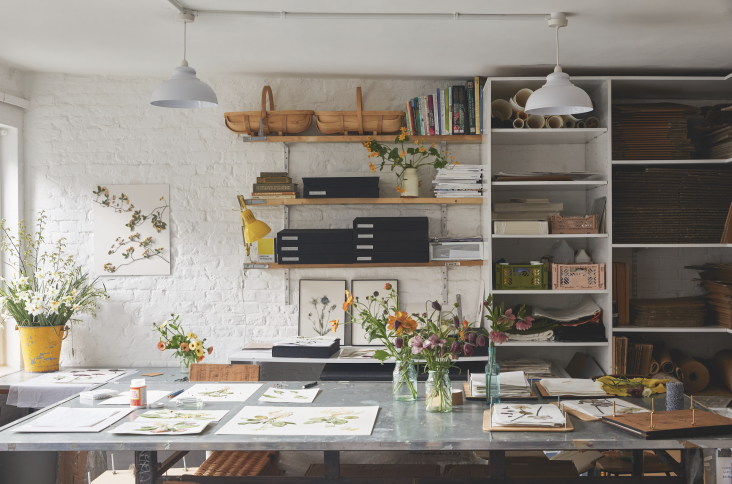London’s floral studio JamJar Flowers has been innovating since Melissa Richardson, a model agent turned florist, started her business channelling the naturalistic simplicity of the flowers that she picked as a young girl, arranged simply in jam jars on the kitchen table. Since then— more than a decade later—they’ve gone on to become stalwarts of the city’s flower scene, decorating restaurants, shops, hotels, and endless fashion events, often with large scale installations.
But over the past few years Melissa Richardson and co-conspirator Amy Fielding have ventured into a different area of floral decoration with pressed flowers and, in a similar way, through experimentation and inspiration, started to develop myriad ways to use the simplest of flowers—picked, pressed, and preserved forever. During the pandemic, with their event flowers business almost entirely diminished, they decided to pour all their knowledge about this ancient craft into a book: The Modern Flower Press.

One of the most influential images that kick-started JamJar’s foray into preserving was a photo of a collection of pressed flowers made during the first World War that adorns the bedroom of designer Christian Louboutin at his 13th century chateau in the Vendée region of France. The image inspired one of JamJar’s first pressed flower works, in which individual pressed flowers were mounted onto A3 boards and then framed for an exhibition in Covent Garden. Inspired by this success the duo went on to produce wallpapers of pressed flowers as well as private residential commissions and installations.

The book is divided into short essays on key flowers and plants that you might want to press, from wildflowers and spring bulbs though to summer favorites such as foxgloves, sweet peas, poppies, cornflowers, and nigella (arguably the best flower for pressing with its papers blooms and finely cut foliage). Woven through this are sections that expand on the history of preserving plants. All of this is fascinating, and the authors admit much of it was an education to them, too, as they researched through the first year of the pandemic.

But it’s the endless projects here that will probably be pored over and returned to again and again. We get the lowdown on how to best select, press, and preserve blooms—this is a meticulous process that needs to be done carefully if you want flowers that will last and hold their color. There are so many accessible projects here using dried flowers on tiles, lampshades, tables, and furniture as well as, more simply, topping letters, cards, and gifts or just mounted in frames.

But for the more ambitious, there are larger scale projects that require some planning and forethought‚and, if possible, friends with enormous rambling roses or jasmine who are happy to share some boughs. Last summer Melissa and Amy collaborated on an exhibition for Thyme England, an elegant hotel and estate in the Cotswolds which holds shows and events in its threshing barn. One of the pieces in the show was a stunning triptych of Rosa banksiae. To press these enormous trailing branches they had to make special MDF presses that were large enough for the branches and carefully remove flowers and foliage so that the sprays would be showcased rather than crowded. The result is nothing short of spectacular, with the roses flowing from frame to frame. They make it all look very easy. For now we’ll be starting with some simple nigella stems.

For more Required Reading books, see:
- Required Reading: From Seed to Bloom by Milli Proust
- Required Reading: ‘Grow5: Simple Seasonal Ideas for Small Outdoor Spaces with Just Five Plants’; by Lucy Bellamy
- Required Reading: ‘Wild: The Naturalistic Garden’ by Noel Kingsbury












Have a Question or Comment About This Post?
Join the conversation (0)